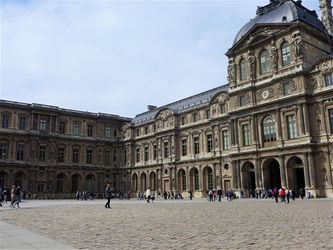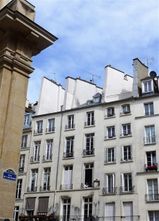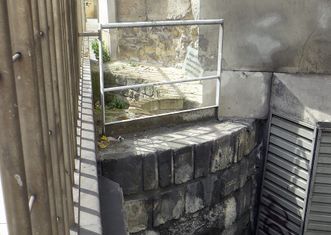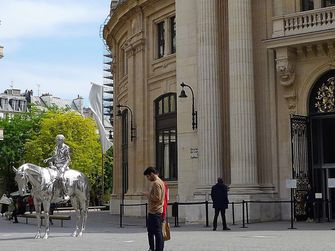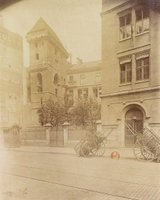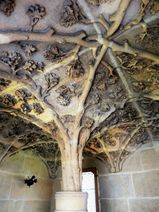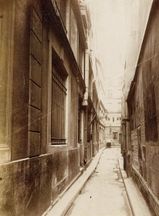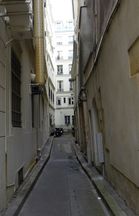Hora fugit - Un peu de Paris
The Wall of Philip II - From Louvre to Marais
Louvre
The wall started approximately opposite the Pont des Arts. It was defended by a large tower (the Tour du Coin) and by the Fortress of the Louvre against possible attacks from the river.
The Louvre fortress located in the southwest quadrant of the today Cour Carrée was built outside the wall. It was itself defended by a wall with ten towers and by a keep also used as a prison and a safe of the royal treasury. It was only used as a defensive castle. The Palais de la Cité remained the royal residence, until King Charles V decided by 1360 to transform the Louvre fortress into a palace.
It is rather hard to imagine how was the fortress. The best is to visit its impressive foundations under the Louvre (Pavillon de Sully). They were discovered during important excavations done in the 1980s. The visit of the medieval Louvre can also provide a very good understanding of the Louvre's evolution, well illustrated by short videos.
L’enceinte traversait l’actuelle cour Carrée du Louvre, puis bifurquait dans l’axe de l’actuel Temple Protestant de l’Oratoire, construit à cheval sur l’ancien tracé de la muraille.
Rue de l'Oratoire - Rue Saint-Honoré
The wall was crossing the today Cour Carrée of the Louvre; it then was running along the current Protestant church of the Oratory, where remnants can be seen in the basement of the sacristy. When we walk along the rue de l'Oratoire, we follow the internal side of the wall.
The rue Saint-Honoré, one of the busiest streets of the medieval city, was ending at the today number 148, where stood the fortified gate of Saint-Honoré. At this level, the wall was slightly going toward the north-east that same direction taken today by the tall white chimneys of the building at the nr 148, precisely where the wall was located.
Rue du Louvre
Let's now take the rue du Louvre on the left. At number 11, the inner part of a tower is so discreet that it gets almost no attention from the passers-by, too hurried and jaded. I am sure that they even took me for a metro maintenance employee when I was looking through the gate to take a picture of the tower base.
Then, the wall was passing not far from where is today the beautifully restored Bourse du Commerce-Collection Pinault. No remnants of the wall there. Only my imagination can make me see a medieval knight in his shining armour where Charles Ray placed his modern Horse and Rider statue.
Let's now turn right into rue Coquillière and then rue du Jour, which is a former inner walkway of the wall. Remains of the wall are still visible in some courtyards and in the basement of the fire station.
We now arrive at rue Montmartre where we turn left into rue Etienne-Marcel where we will stop in front of the Jean Sans Peur tower. This tower, built later in 1408, was standing against the wall of Philip Augustus, of which some remains can still be seen.
Tour de Jean Sans Peur
The Duke of Burgundy, by name John The Fearless (Jean Sans Peur), could somehow fear the revenge of the King after the murder in 1407 of his cousin Louis d'Orléans, the King's brother. For the Duke of Burgundy, peace with England was necessary for economic reasons. Opposed to Louis d’Orleans who rather wanted to take up arms in order to regain the territories occupied by England, he decided his elimination. After that, in order to reinforce his protection, the Duke of Burgundy built a fortified tower in his main residence, an old mansion from 1270 built against the wall of Philip Augustus. If the wall had no longer any defensive role in the 15th century Paris, it however provided an additional protection for the duke who could also use hidden passage ways under the wall to escape. There was also an old tower of the wall, still visible inside the museum.
Tour de Jean sans Peur
rue Etienne Marcel
Atget – 1899
The small museum about Medieval life is very didactic. It also provides a good opportunity to refresh on the hundred years war and the conflicts between the Dukes of Burgundy and the French Crown. It offers also the opportunity to see a unique architectural gem: The ceiling in the stairwell, carved from stone is covered with a delicate web of branches and leaves.
Rue Saint-Denis
We now continue along rue Etienne-Marcel up to rue Saint-Denis. At the junction of this street with rue Turbigo, there was a gate known as the Porte aux Peintres. The Impasse des Peintres, a narrow dead end is a remain of the wall walk.
112, rue Saint-Denis – Impasse des Peintres
Atget – 1907
(Musée Carnavalet)
Texte / Photos : Martine Combes
Contact / newsletter:
